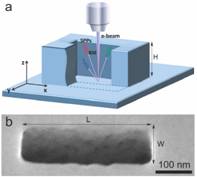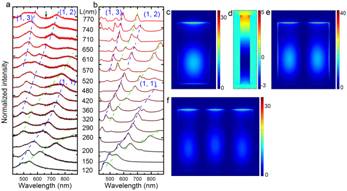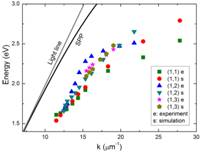垂直腔纳米表面等离激元(SPP)中的共振模式形成物理机制
垂直腔面发射激光器(VCSEL)在光通信和传感器等领域有着重要的应用,由于衍射极限的限制,光的VCSEL通常无法做到纳米尺度,为了获得纳米尺度的垂直腔激光器,就需要利用表面等离激元(SPP)的垂直腔。
最近,俞大鹏教授团队和张家森教授团队继续合作,由博士生朱新利等提出了SPP垂直纳米腔,该腔为中空的长方体结构,五面为金属银,一面为空气窗口作为输出镜。他们利用前期提出的基于电子束曝光的PMMA模板剥离法[Xinli
Zhu, Yang Zhang, Jiasen Zhang, Jun Xu, Yue Ma, Zhiyuan Li and Dapeng Yu,
“Ultrafine and Smooth Full Metal Nanostructures for Plasmonics”, Advanced
Materials 22(39), 4345-4349 (2010)],成功地制备出三种SPP垂直纳米腔,分别包含一个、两个和三个空气窗口。SPP在垂直腔中以金属-介质-金属(MIM)结构的对称模式存在,该模式不会随着腔的宽度的减小而截止,因此可以获得远小于波长的宽度。利用宽度的改变还可以调控SPP的色散,获得极小的模体积。他们利用扫描电子显微镜中安装的阴极荧光光谱仪对SPP垂直纳米腔进行了系统的研究,结合理论模拟,给出了腔中模式的形成机理,得到了SPP的色散关系。实验中在70nm宽的腔中获得的最小模体积达0.0014
m3。在垂直纳米腔中利用调控SPP的色散可以获得高的Q因子与模体积的比值,将在研究荧光粒子与局域电磁场的相互作用及纳米激光器等方面有着重要的应用。该结果于2月1日发表在《纳米快报》(Nano
Letters, Xinli Zhu et al., http://pubs.acs.org/doi/abs/10.1021/nl104024j)的网络版上。
该研究工作得到了国家自然科学基金委、科技部973计划以及介观物理国家重点实验室自主科研项目等的大力资助。

| 
| 
|
Figure 1
| Figure 2
| Figure 3
|
Figure 1. Plasmonic vertical nanocavity. (a) Schematic of a single nanocavity.
(b) 30°-tilted SEM image of a representative cavity with length, width, and
height of 360, 120, and 500 nm, respectively.
Figure 2. Resonances and mode patterns of plasmonic nanocavities with 70 nm
widths, 500 nm heights, and increasing lengths. (a) CL spectra of 16
nanocavities with cavity lengths increasing from 120 (bottom) to 770 nm (top).
(b) Calculated spectra using the FDTD method. Spectra are offset vertically for
clarity. The black arrow at 655 nm indicates that the spectra were collected
twice at the same position due to the limited measuring range of the
spectrophotometer. (c), (d) Calculated mode field intensity patterns and
electric field amplitude of a 260 nm-long cavity at 635 nm in the y = -35 nm and
x = 0 planes, respectively. (e), (f) Calculated mode patterns in the y = -35 nm
plane of 420 and 610 nm-long cavities at 539 and 523 nm, respectively.
Figure 3. Experimental and calculated dispersions of plasmonic modes (1, 1),
(1, 2), and (1, 3) in vertical nanocavities. The grey and black lines
respectively represent the dispersions of light in a vacuum and SPPs on an
infinite Ag film.
Plasmonic Vertical Resonant Nanocavities, Xinli Zhu, Jiasen Zhang,* Jun Xu,
and Dapeng Yu,* Nano Letters, in press (2011).

